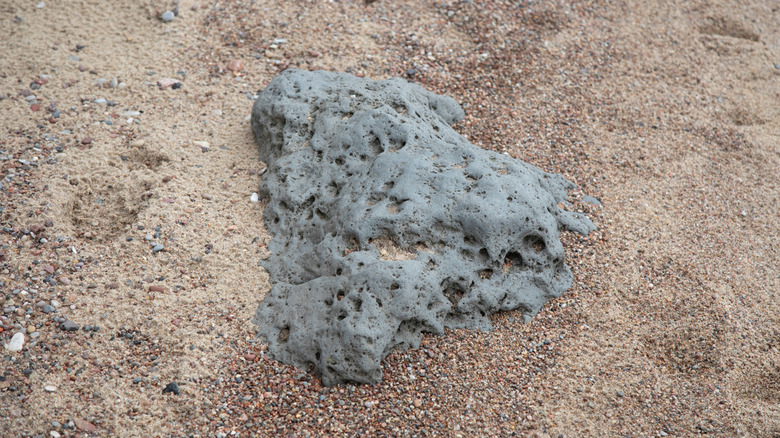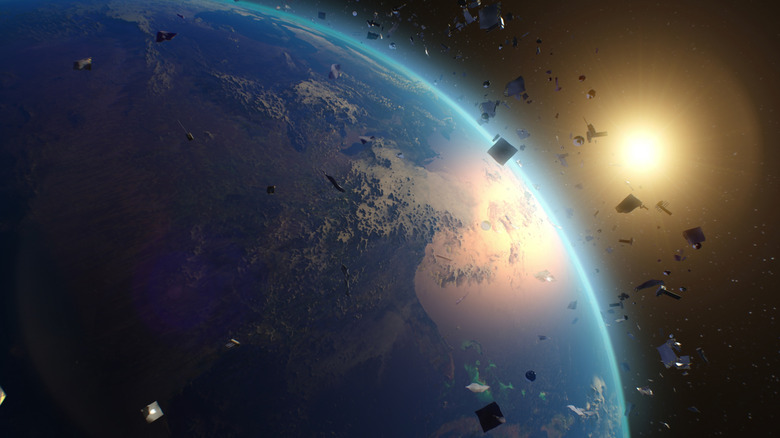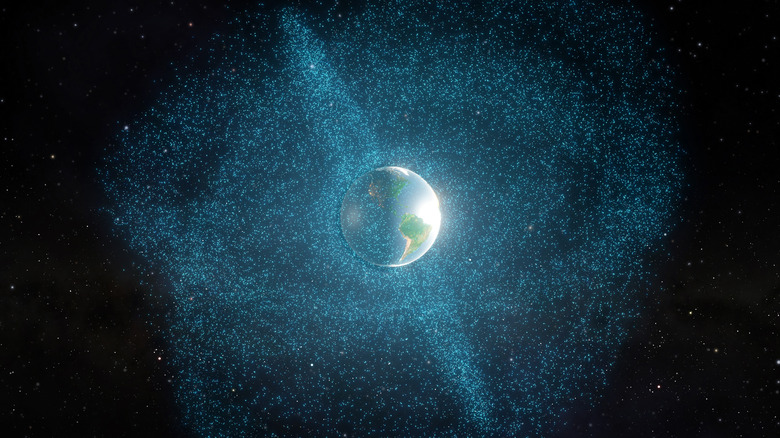The Staggering Amount Of Space Debris That Hits Earth Daily
Surely one of humankind's biggest existential fears — aside from wondering whether AI is a good technology or a bad one destined to result in our doom — is the prospect of an asteroid hitting Earth. It's happened countless times already, with major asteroid impacts having been responsible for some of the biggest events in our planet's history. Beyond the asteroid that wiped out the dinosaurs 66 million years ago, there was also the time a Mars-sized asteroid, known as Theia, struck the planet 4.5 billion years ago and is thought to have helped create the moon as a result of the debris flung into space by its impact.
Today, an asteroid impact remains one of the biggest threats to our planet from space. But the surprising truth is that Earth is constantly being hit by space debris. Roughly 48.5 tons of meteoric material falls toward Earth every day, but 95% of it burns up in our atmosphere. Much of this cosmic dust is too small to even see, measuring less than a millimeter in size, but thousands of tons of it land on the surface of our planet every year and it's not just this space dust that's hitting Earth's surface on a regular basis. There's actually a surprising amount of other space debris that makes it to our planet, and some of it poses a real threat.
The astounding amount of meteoric material that falls to Earth
The estimated 48.5 tons of meteoric material that falls towards Earth every day burns up when it enters our atmosphere and for larger pieces of debris, this often results in the material producing a bright trail in the sky — a phenomenon we refer to as "shooting stars." Multiple shooting stars constitute a meteor shower, and sometimes, as in one instance from 2024, we get to witness a rare double meteor shower. Luminescent streaks of light in the sky are a lot more pleasant than the concept of our world being struck by a giant asteroid, but what about the small percentage of meteoroids that make it through Earth's atmosphere and hit the surface?
Meteors that land on our planet are called meteorites, and while only a fraction of meteors actually make it that far, there are still a surprising amount of impacts every year. In April 2020, a team led by University of Manchester mathematician Geoffrey Evatt published the findings of two searches carried out in the Outer Recovery Ice Fields in East Antarctica in 2019 and 2020. The study, published in Geology, resulted in a new estimate for the amount of space rock that actually hits Earth's surface each year: over 36,000 pounds. It should be noted that this estimate refers to meteorite material weighing above 0.11 pounds. Still, that's a lot of meteors that are making it through our atmosphere each year and actually landing on the surface of our planet. What's more, meteoric material isn't the only space debris that falls to Earth.
The human-created space junk that poses a threat to Earth
As if worrying about asteroids wasn't enough, there's a whole man-made junk yard of debris orbiting our planet that has resulted in multiple pieces of scrap falling to Earth. Described by NASA as "an orbital space junk yard," Low Earth orbit (LEO) refers to objects orbiting our planet within an altitude of 1,200 miles or less. This area is close enough to Earth's surface that it makes for convenient transportation, communication, and observation, and is currently home to the International Space Station. But it's also home to space junk ... quite a lot of it.
While we go about our lives down here on Earth's surface, there are millions of pieces of space junk orbiting our planet in LEO, which together weigh roughly 6,000 tons. NASA's Orbital Debris Program Office estimates that there are around 500,000 marble-sized objects in Earth's orbit, and more than 100 million objects measuring 1 mm or smaller, all of which are dangerous when traveling at orbital speeds. This space dross can reach 18,000 miles per hour, which means it's flying around at speeds almost seven times faster than a bullet.
Almost all of this debris comes from us humans, and is made up of spacecraft pieces, paint flecks, rocket parts, broken satellites, and even lost tools used by astronauts. What makes this space graveyard particularly dangerous is not only that it poses a threat to any spacefaring nation sending their craft and personnel into orbit, but that these pieces of junk can sometimes fall to Earth, to the extent that the United Nations has created an international treaty to deal with such events.
Space junk re-entries are increasing
To be sure, even with the surprising amount of space debris orbiting our planet, you're unlikely to be hit by a falling satellite any time soon. While roughly 200–400 objects enter Earth's atmosphere every year, they usually burn up upon re-entry. Even if they make it through, our planet's surface happens to be 70% water, making it unlikely that these larger objects cause any harm.
That said, there have been several instances when falling man-made debris has caused major issues. In 2022, a large piece of a rocket used to deliver a module to China's Tiangong space station fell back to Earth, causing a portion of Spain's airspace to close. The debris, which measured 98 feet in length and weighed between 18 and 25 tons, ultimately landed in the Pacific Ocean, but there have been much more dangerous and worrying examples of man-made debris falling to Earth. In 2024, A Florida family sued NASA after a battery support mount from the International Space Station hit their house. While nobody was hurt, it was a reminder of how dangerous space junk re-entering Earth's atmosphere can be.
Making matters worse is the fact that re-entries are increasing. A 2025 report published in Nature looked at uncontrolled re-entries of space objects, noting how such events pose a real risk to aircraft. What's more, the researchers urged that the risk is rising due to increases in both re-entries and flights, and that the trackable objects in orbit more than doubled in the last decade, noting how large re-entries now occur almost weekly. Still the likelihood of falling man-made space debris causing a casualty on the ground is thought to be around 1 in 10,000.



